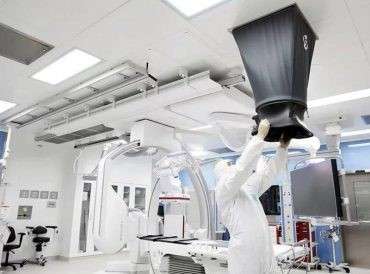In today’s rapidly advancing technological landscape, precision and purity are paramount in various industries, from pharmaceuticals to electronics manufacturing. Achieving and maintaining controlled environments where airborne contaminants are meticulously managed is crucial. This is where ISO 14644 cleanroom validation plays a pivotal role. ISO 14644 is a globally recognized standard that sets guidelines for cleanroom classification and monitoring, ensuring the utmost quality and consistency in controlled environments.
Understanding ISO 14644 Cleanroom Validation
Cleanrooms are enclosed spaces where the concentration of airborne particles is controlled and monitored to meet specific cleanliness requirements. These environments are essential in industries where even the tiniest particle can compromise product quality or endanger human health. ISO 14644, titled “Cleanrooms and associated controlled environments,” is a set of standards developed to establish cleanroom classification and performance testing criteria. This standard series provides a structured framework for cleanroom design, operation, and validation.
ISO 14644 cleanroom validation serves as a comprehensive approach to ensure that cleanrooms consistently meet the specified cleanliness levels. This validation process involves several steps, each designed to guarantee the reliability of cleanroom performance:
1. Classification
The ISO 14644 standard categorizes cleanrooms into different classes, ranging from ISO Class 1 (the cleanest) to ISO Class 9 (the least clean). Classifications are based on the maximum allowable particle counts per cubic meter for particles of specific sizes. Establishing the correct classification is a crucial first step in cleanroom validation, as it sets the cleanliness target.
2. Design and Construction
Cleanroom design and construction must align with ISO 14644 standards to maintain the desired cleanliness level. Factors such as room layout, airflow, and filtration systems are carefully considered during this phase to ensure effective particle control.
3. Operational Qualification (OQ)
After construction, cleanrooms undergo an OQ process. This step involves testing and documenting the performance of critical systems, such as HVAC, filtration, and airflow patterns, to confirm that they meet the specified requirements. OQ ensures that the cleanroom is functioning as intended.
4. Performance Qualification (PQ)
PQ focuses on verifying the cleanroom’s ability to consistently meet cleanliness standards during regular operations. This includes continuous monitoring of particle counts, temperature, humidity, and other relevant parameters. PQ is an ongoing process, and cleanrooms must undergo routine monitoring to maintain their validated status.
5. Monitoring and Control
Continuous monitoring and control are essential to maintain the cleanliness of the cleanroom. ISO 14644 specifies regular particle count measurements and defines alert and action levels to prompt corrective actions when contamination levels deviate from acceptable limits.
6. Documentation
Proper documentation is a fundamental aspect of ISO 14644 cleanroom validation. Detailed records of all validation activities, including design, construction, OQ, PQ, and monitoring results, must be maintained to demonstrate compliance with the standard.
The Widespread Applications of ISO 14644 Cleanroom Validation
ISO 14644 cleanroom validation is not limited to a single industry; its principles are applied across a wide spectrum of sectors where cleanliness and precision are paramount. Here are a few notable examples:
1. Pharmaceutical and Biotechnology
In pharmaceutical manufacturing, any contamination can jeopardize product quality and patient safety. Cleanrooms compliant with ISO 14644 are used to produce sterile drugs, vaccines, and medical devices.
2. Electronics Manufacturing
The electronics industry relies on cleanrooms to produce microchips and other sensitive electronic components. Maintaining cleanroom standards is essential to prevent defects in electronic devices.
3. Aerospace and Defense
In aerospace and defence, cleanrooms are employed to assemble and test aerospace components, satellites, and military equipment. ISO 14644 ensures the reliability of these critical systems.
4. Healthcare
Hospitals and healthcare facilities use cleanrooms for compounding sterile medications and conducting research in controlled environments. Compliance with ISO 14644 standards is essential to ensure patient safety.
5. Food and Beverage
Cleanrooms are used in the food and beverage industry to produce products with stringent purity requirements. Ensuring that these environments meet ISO 14644 standards guarantees product safety and quality.
Benefits of ISO 14644 Cleanroom Validation
ISO 14644 cleanroom validation offers numerous advantages to industries that rely on controlled environments:
1. Quality Assurance
By adhering to ISO 14644 standards, industries can consistently produce high-quality products, reducing the risk of contamination-related defects.
2. Regulatory Compliance
Many regulatory bodies, such as the U.S. Food and Drug Administration (FDA) and the European Medicines Agency (EMA), require compliance with ISO 14644 standards in various industries. Validation ensures regulatory compliance.
3. Cost Reduction
Properly validated cleanrooms are more efficient and less prone to operational issues, resulting in reduced downtime and maintenance costs.
4. Risk Mitigation
Validation helps identify and address potential sources of contamination, minimizing the risk of product recalls and damage to brand reputation.
5. Improved Safety
Cleanrooms play a critical role in ensuring the safety of both products and personnel. Validation enhances safety by maintaining the desired cleanliness levels.
Future Trends in Cleanroom Validation
As technology continues to evolve, so do the challenges associated with maintaining cleanrooms and controlled environments. Some emerging trends in cleanroom validation include:
1. Automation
The use of automation and robotics for cleanroom monitoring and maintenance is becoming more prevalent, enhancing efficiency and accuracy.
2. Data Analytics
Advanced data analytics tools are being employed to gain deeper insights into cleanroom performance and predictive maintenance.
3. Nanotechnology
As industries venture into nanoscale manufacturing, cleanroom requirements are becoming even more stringent, demanding innovative validation techniques.
4. Sustainable Practices
Cleanroom design and operation are increasingly focusing on sustainability and energy efficiency, aligning with global environmental goals.
Conclusion
ISO 14644 cleanroom validation is a critical component of industries where cleanliness and precision are non-negotiable. It provides a structured framework for the design, construction, and ongoing maintenance of controlled environments, ensuring that they consistently meet cleanliness standards. Compliance with ISO 14644 not only enhances product quality but also helps industries meet regulatory requirements and adapt to evolving technology trends. As industries continue to push the boundaries of precision and purity, cleanroom validation will remain a cornerstone of their success.










